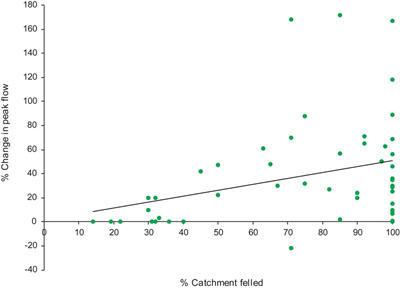
This is a really important insight by @andyheald on how restocking figures can give a clearer idea of how our woodlands are really expanding and changing. Let me try to visualise and explain it... 1/ 
https://twitter.com/andyheald/status/1443884629379977217

🌲 It's rare for broadleaf to be felled and restocked, so restocking can be assumed to be on former conifer.
🌲 Much conifer restocking isn't grant-funded, so its statistics aren't reliable, but replacing it with broadleaf often is. 2/
🌲 Much conifer restocking isn't grant-funded, so its statistics aren't reliable, but replacing it with broadleaf often is. 2/
So 'broadleaf restocking' represents broadleaf woodland creation, over and above what's in the 'new woodland' statistics, but on former conifer instead of former open land. 3/
🌳We can add broadleaf restock to new woodland to get total increase in broadleaf area,
🌲And subtract broadleaf restock from new conifer planting to get net increase (or decrease) in conifer area. 4/
🌲And subtract broadleaf restock from new conifer planting to get net increase (or decrease) in conifer area. 4/
So we can see:
🌳In England and Wales, broadleaf woodland increased significantly more than the 'new woodland' statistics tell you;
🌲While conifer area decreased by just over 1000 hectares. 5/
🌳In England and Wales, broadleaf woodland increased significantly more than the 'new woodland' statistics tell you;
🌲While conifer area decreased by just over 1000 hectares. 5/

In Scotland, both types of woodland expanded, but broadleaf accounted for over half (54%) of net expansion, not the 35% often quoted. 



Across the UK as a whole, conifers (usually for wood production🏗️) only accounted for 30% of net expansion, the vast majority was broadleaf (usually for wildlife/amenity🐾). 7/ 



Why are broadleaves replacing conifers? Good reasons!
🌳Restoring Plantations on Ancient Woodland - where conifers historically replaced broadleaves,
🌳Restructuring - diversifying old conifer plantations with native trees at harvest, to enhance the whole forest for wildlife.
🌳Restoring Plantations on Ancient Woodland - where conifers historically replaced broadleaves,
🌳Restructuring - diversifying old conifer plantations with native trees at harvest, to enhance the whole forest for wildlife.
Why is it concerning?
Later in Forestry Statistics we read that the UK remains the second biggest net importer of wood products in the world, after China, and imports 80% of the wood products we need. Yet England and Wales are reducing their timber producting capacity. /9

Later in Forestry Statistics we read that the UK remains the second biggest net importer of wood products in the world, after China, and imports 80% of the wood products we need. Yet England and Wales are reducing their timber producting capacity. /9


We also read in Forestry Statistics that carbon sequestration by the UK's forests is projected to fall.
We are not planting as many conifers - which capture carbon faster and produce the timber we need - as we might have thought - and as we need. /10
We are not planting as many conifers - which capture carbon faster and produce the timber we need - as we might have thought - and as we need. /10

Conclusion: It's vital we delve beyond headlines to understand how our forests are changing. Native broadleaves are replacing conifers for good reason, but it's vital they're compensated, by prioritising new conifers on suitable ground, for timber, carbon, and farm income. 11/11 

Full link to @Forest_Research's Forestry Statistics 2021, graphs, explanatory text, data downloads for you to play with, can be found here: forestresearch.gov.uk/tools-and-reso… 

@threadreaderapp unroll
• • •
Missing some Tweet in this thread? You can try to
force a refresh















